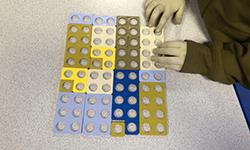As the new football season gets under way the statistics say every squad in the land will have one player who suffers from colour blindness.
However, lobbying by organisation Colour Blind Awareness has set out to ensure the condition will not be overlooked for much longer in sport, or more importantly in schools.
Colour Blind Awareness Day 2017 took place on September 7, with a focus on football this time around – and removing the stigma attached to colour blindness. Resources included clips and pictures of teams playing in colours that appear the same to colour blind players and fans.
However, no elite footballers were prepared to admit they had the condition, in the same way children were often embarrassed to mention their problems in the classroom.
Kathryn Albany-Ward, the founder of Colour Blind Awareness, told Optician: ‘Football has been the first sport to look at colour blindness properly, but if we could get some current players to share our hashtag [#Iam1in12] that would really help.’
She founded the campaign group after her son was diagnosed with colour blindness, and quickly discovered schools and teachers knew little about the three main types of colour blindness.
Moreover, she was shocked when colour blindness screening was removed from the government’s Healthy Child Programme in 2009, all based on evidence collected in 1958 when exams were all conducted in black and white. Given the lack of screening currently in place, Colour Blind Awareness has called for exam papers to revert to the black and white format, which at least did not discriminate.
The current system has effectively put the onus back onto school teachers and optometrists to diagnose colour deficiencies on an ad hoc basis.

Albany-Ward (pictured) said: ‘Parents don’t realise there is no obligation for optometrists to screen for colour blindness in England, although there is in Scotland.
‘I would really like to see optometrists and opticians remember that although they can’t do anything to correct colour blindness they can give the right advice for a family to take away from the practice, including resources and further information.
‘At the moment a lot of children panic and don’t realise it can be worked around once diagnosed.’
Meanwhile, she had experienced resistance from a large multiple chain which said it was unable to make colour tests routine because each practice was under a unique ownership structure.
Colour Blind Awareness Day
This year’s sport-focused awareness campaign follows hot on the heels of a cricket-related storm.
Last month, Colour Blind Awareness wrote to the England and Wales Cricket Board (ECB) to demand a review of its new pink cricket ball. Introduced for a day-night test match, colour blind people had contacted the charity to say they could not follow the ball.
Professor Andrew Stockman of Moorfields Eye Hospital told the Daily Telegraph that pink was not the best colour for colour deficient players or fans if the ball is of the same brightness as the green or brown grass or a grey background.
An ECB spokesman told the newspaper it had tested the ball thoroughly beforehand and sought feedback from players, coaches, officials and fans on their experiences.
However, the Football Association published guidance on colour blindness, to raise awareness of its impact on the game, in June.
Created in conjunction with Colour Blind Awareness, the 40-page guide explained different types of colour blindness, answering common questions and suggesting positive interventions with those who may be affected.
It included best-practice visual examples to avoid kit clashes and a series of simulations to show the normally sighted what colour blind people are likely to see.
The guidance explained the main colour blind issues in football were found in kit clashes, equipment, venues, information such as match day programmes and ticket purchasing and TV coverage using graphics and long-distance camera angles.
Kit clashes were deemed more likely under floodlights, meaning evening matches were particularly difficult for those affected.
Former Charlton Athletic and Ipswich Town midfielder Matt Holland, who is colour blind, said at the time: ‘In one particular match when we were in red and the opponents were in dark green I couldn’t tell the colours apart. I had to really concentrate in that game looking at socks because they were easier for me to distinguish. There was nothing else I could do.’
Similar initiatives have been launched by European football body UEFA, which last summer held practice matches alongside the Europa League final where guest players wore red and green kits – the most common colour clash. There was also a one page advert for the campaign in the England vs Slovakia official match programme earlier this week.
Albany-Ward added: ‘We’ve had amazing support from the football world and we’re incredibly grateful to the FA and UEFA for their continued enthusiasm and active involvement to address the issues surrounding colour blindness in football. We hope that promotion of these issues via football will help to raise awareness worldwide.
‘There’s a stigma attached to being colour blind. Colour blind people don’t want to be considered less capable than others. Colour blindness often makes people feel vulnerable, embarrassed and even stupid at times. The FA Guidance contains some great personal impact stories which explain how people can feel disadvantaged by their colour blindness.

‘Without raising the profile of colour blindness nothing will change, meaning our colour blind children, friends, relatives, colleagues and sporting heroes will continue to face discrimination in school, at work, watching and playing sport, down at the shops or just browsing on the internet.’
Despite the campaigning, colour blindness remained undiagnosed before secondary school in 80% of cases.
Lack of common sense
Albany-Ward has written to government health ministers calling for the introduction of colour blindness tests for children, but with frustrating results.
‘If you want something to be recognised you have to go through many steps. Common sense has gone out of the window and everyone is hiding behind rules and regulations because of cost. As an organisation, we are too small to take on that research,’ she added.
However, a breakthrough has been made by Dr John Barry, honorary lecturer in psychology at University College London (UCL), who has created the first scale that measures the quality of life impact of being colour blind.
In collaboration with the Academic Unit of Ophthalmology at the University of Birmingham, he conducted a study of 419 people, finding that colour blindness can significantly impact quality of life for health, emotions and especially careers. Colour blindness caused problems in many areas of life, including problems playing sports, he found.
Albany-Ward will hope such evidence goes some way towards replacing public health findings collected 60 years ago, which still govern the eye care of colour blind people today.
Back to school reminders
Latest research has suggested parents do not automatically make the possible link between learning and vision.
In a study conducted by Optegra Eye Health Care earlier this year, only one in three adults thought their child falling behind with schoolwork may indicate they need an eye test.
The majority, 58%, did not know if their school offers a vision screening programme, while a quarter said their school did not.
Optegra’s survey of 2,009 UK adults found 45% did not realise a child sitting close to the television can indicate they need an eye test, while 30% did not think a child unable to see the whiteboard or struggling with reading may need an eye test.
Dr Clare O’Donnell, head of eye services at Optegra, said: ‘We would urge parents not to take it for granted that their child’s vision will be screened at school, as not all schools do so. Having said that, it is often the case that the first time parents are alerted to a problem, it is by teachers.’
Meanwhile, the College of Optometrists this week announced it was encouraging parents to monitor their child’s vision as the new school term commenced, publishing an online infographic.
